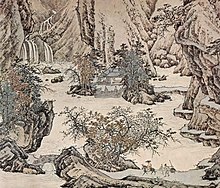Qiu Ying

Qiu Ying ( Chinese 仇英 , Pinyin Qiu Ying , W.-G. Ch'iu Ying ; * probably in 1494 in Taicang , † 1552 in Suzhou ) was a Chinese literati painter and calligrapher and is next to Shen Zhou , Tang Yin and Wen Zhengming as a of the four masters of the Ming dynasty , who had a lasting influence on subsequent generations of artists. Of these four masters, Qiu Ying was the most versatile.
Qiu was born into a poor family in Taicang near what is now Shanghai and learned the art of painting from Zhou Chen in Suzhou , then an important cultural center where painting at the Wu school had developed . He then earned his living by creating paintings with a wide variety of motifs in a large number of styles for wealthy patrons. Depictions of landscapes, people, gardens, plants and religious motifs were created. All of his works emphasize the aesthetics of the Ming Dynasty with lush picture structures and bold colors. They were used as gifts by Qius' supporters or as a reminder of important events. He also made copies of older masterpieces and integrated motifs as such into his own works, making it impossible today to determine which works were by Qiu.
Qiu worked for three patrons, with each of whom he stayed for several years. These were Chen Guan from Suzhou, Zhou Fenglai from Kunshan and the well-known art collector Xian Yuanbian from Jiaxing .
One of the best-known works by Qiu is the picture scroll Farewell to Xunyang , which was created as an illustration for the poem The Sound of the Pipa by Bai Juyi . Based on the painting of the Tang Dynasty , Qiu worked here with green and blue highly opaque pigments to depict the blue and green tones of the sky and the hills. He combined these with strong red, orange, purple and yellow tones to depict the figures, plants and bodies of water. This is a typical example of the sensual and idealized representation of nature by Qiu. The work Fu over the red cliff , however, is a representative of the taste of the 16th century. The colors are translucent and muted, the brushstrokes soft. The work Landscape in the manner of Li Tang imitates the painting style of the artist Li Tang from the Song Dynasty .
The portrayal of people, especially women, is characteristic of Qiu Ying. Typically you will find oval faces with clear contours in three-quarter view, slanted eyes, narrow eyebrows and implied lips, the corners of which point steeply upwards. The people in the garden of the golden valley , which is the garden of the great entrepreneur Shi Chong , are an example of this. This work shows Shi, accompanied by female servants, as he welcomes guests to one of his lavish entertainment events. The clothing of the people and especially the drapery was shown here by Qiu particularly accurately. In the painting Music under Banana Trees , which was probably created under the influence of the Nanjing School , the brushstrokes are much freer and more irregular. In the picture, asking for a donkey for Mr. Zhu , Qiu imitates the 11th century Baimiao style.
Web links
- Literature by and about Qiu Ying in the catalog of the German National Library
Individual evidence
- ↑ a b c d Ellen Johnston Laimg: Qiu Ying . In: Jane Turner (Ed.): The dictionary of art . tape 25 . Grove, Oxford 1996, ISBN 1-884446-00-0 , pp. 784-786 .
| personal data | |
|---|---|
| SURNAME | Qiu, Ying |
| ALTERNATIVE NAMES | Shifu, Shizhou, 实 父, 十 洲 |
| BRIEF DESCRIPTION | Chinese painter and calligrapher |
| DATE OF BIRTH | 1494 |
| PLACE OF BIRTH | Taicang |
| DATE OF DEATH | 1552 |
| Place of death | Suzhou |
